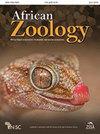Changes in Social Dominance in a Group of Subadult White Rhinoceroses (Ceratotherium simum) after Dehorning
IF 0.5
4区 生物学
Q4 ZOOLOGY
引用次数: 1
Abstract
In many social species physical attributes correlate with dominance rankings and influence the outcomes of dyadic interactions. We investigated the processes that affect white rhinoceros' social behaviour in response to a reduction in horn size asymmetries within a group of subadult individuals. We monitored agonistic social interactions and the orderliness of social rankings between six free ranging rhinoceroses before and after they underwent a second dehorning procedure. We used a modified version of Landau's h′ to measure linearity, a score of steepness to measure power asymmetry, and a measure of triangle transitivity to assess relationships in the presence of null dyads. Agonistic social interactions were significantly greater after the monitored dehorning procedure. Hierarchies possessed significant steepness and transitivity prior to the procedure, but not after. Linearity was non-significant and rank order did not correspond with changes in horn size or age. Our results provide the first evidence of a dominance hierarchy among free-ranging white rhinoceroses outside of reproductive competition, but indicate that physical attributes alone do not explain social rankings. Rhinoceroses transitioned to a more egalitarian dominance structure than a despotic one after the procedure, but dominance ranks were only weakly differentiated within the group. Although a reduction in horn asymmetries may increase agonistic behaviours via psychosocial or behavioural changes, drier climatic conditions cannot be ruled out as the causative factor and because the subadult group stayed together, rather than dispersing, any increased fitness costs are likely to be minimal and outweighed by the benefits of group membership.一群亚成年白犀牛去角后社会优势地位的变化
在许多社会物种中,物理属性与优势等级相关,并影响二元相互作用的结果。我们研究了影响白犀牛社会行为的过程,以应对一群亚成年个体中角大小不对称的减少。我们监测了六头自由放养的犀牛在接受第二次去角手术前后的激烈社会互动和社会排名的有序性。我们使用了朗道h '的修正版本来衡量线性度,用陡峭度评分来衡量权力不对称,用三角形传递性来评估零二分体存在时的关系。在监测去角过程后,激动性社会互动显著增加。层次结构在程序之前具有显著的陡峭性和传递性,而在程序之后则没有。线性关系不显著,等级顺序与角大小或年龄的变化不对应。我们的研究结果为自由放养的白犀牛在繁殖竞争之外的优势等级提供了第一个证据,但表明身体特征本身并不能解释社会排名。手术后,犀牛过渡到一个更平等的统治结构,而不是一个专制的结构,但统治等级在群体内只是微弱的分化。虽然角不对称的减少可能会通过社会心理或行为变化增加对抗行为,但不能排除干燥的气候条件是致病因素,而且由于亚成年群体聚集在一起,而不是分散,任何增加的适应成本可能是最小的,并且被群体成员的利益所抵消。
本文章由计算机程序翻译,如有差异,请以英文原文为准。
求助全文
约1分钟内获得全文
求助全文
来源期刊

African Zoology
生物-动物学
CiteScore
2.60
自引率
9.10%
发文量
18
审稿时长
>12 weeks
期刊介绍:
African Zoology , a peer-reviewed research journal, publishes original scientific contributions and critical reviews that focus principally on African fauna in terrestrial, freshwater, and marine ecosystems. Research from other regions that advances practical and theoretical aspects of zoology will be considered. Rigorous question-driven research in all aspects of zoology will take precedence over descriptive research. The Journal publishes full-length papers, critical reviews, short communications, letters to the editors as well as book reviews. Contributions based on purely observational, descriptive or anecdotal data will not be considered.
The Journal is produced by NISC in association with the Zoological Society of South Africa (ZSSA). Acceptance of papers is the responsibility of the Editors-in-Chief in consultation with the Editors and members of the Editorial Advisory Board. All views expressed are those of the author and not necessarily those of the Editors or the Department.
 求助内容:
求助内容: 应助结果提醒方式:
应助结果提醒方式:


